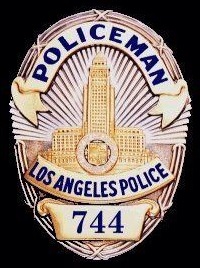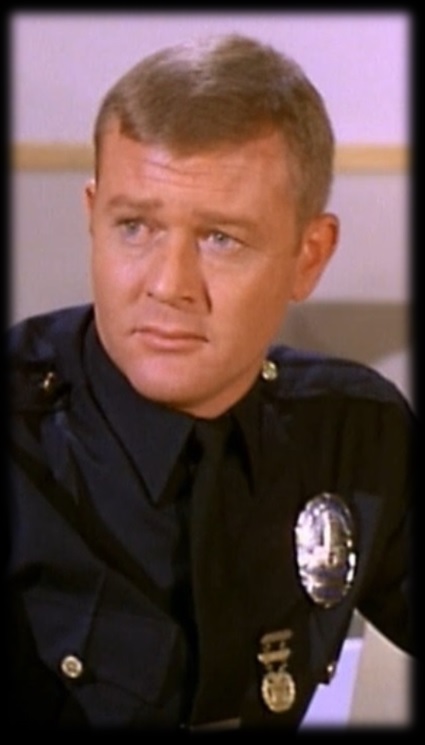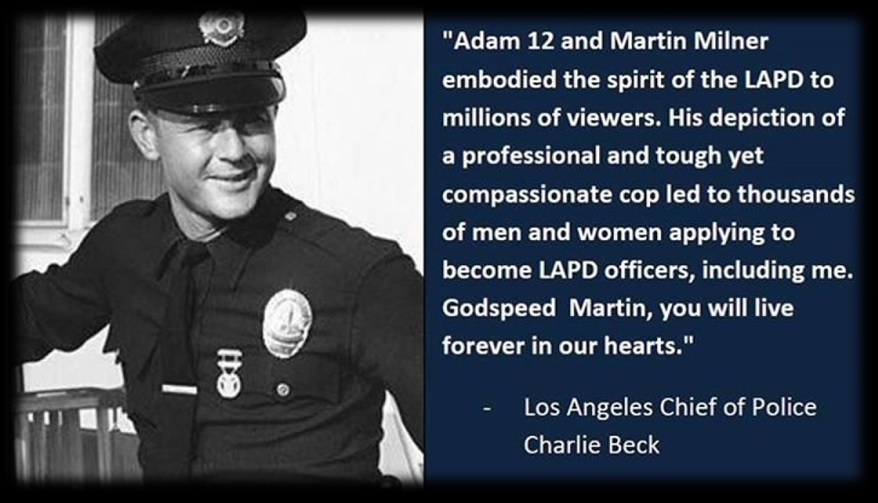



Carlsbad California. With his loving family at his side, including Judy his wife of 59 years, one of the most influential members of American law enforcement died peacefully at the age of 84 on Sunday, September 6, 2015.
There will probably never be an accurate number of just how many men and women pursued careers in law enforcement because of him; it could be tens of thousands. Even Chief Charlie Beck admitted this man was one of the reasons he joined the LAPD in 1977.
Ironically, despite being perhaps one of the greatest police recruiter’s ever, LAPD Officer III+I Peter J. Malloy, serial number 10743, badge 744, never really existed except on TV. That role was portrayed by veteran Hollywood actor Martin Milner.
I knew Martin Milner. Marty was a friend of mine. There will never be another like him.
Like many of my generation, I grew up watching reruns of Adam-12. Like many of my generation, its influence played a part when I decided to pursue law enforcement as a career more than 30 years ago.
Conceived by Dragnet producer Jack Webb, the pilot for this gritty drama centering on the professional lives of Officer’s Malloy and Reed, was shot in 1967. The show was ultimately purchased by NBC where it ran from September 21, 1968, until May 20, 1975.
Like Dragnet, each Adam-12 episode was based on actual cases with names changed to protect the innocent and covered a variety of incidents the officers encountered during a shift, from the tragic to the trivial. Their set was not a squad room or office; the officers watched the changes in American culture through the windshield of their squad car. The show was bold for several reasons. When it was conceptualized, anti-police fervor was at an all time high. Absent sitcoms like “Car-54 where are you” or Andy Griffith, there had never really been a show centered on uniformed cops. To introduce a show like Adam-12, where clean cut but fallible patrol policemen enforced the sometimes not so popular rules of the establishment and delivered a moral lesson, was radical to say the least.
In a move a major network would never consider today, NBC choose to run the series for one year as a public service even if it wasn’t supported by the ratings.
In the series' first episode, directed by Jack Webb, Kent McCord’s character Officer Jim Reed is less than a week out of the academy and eager to begin his career. On his first night the Malloy is assigned the young, raw, rookie. Little does Reed know Malloy had - just three weeks earlier - had lost his partner arresting a robber. Malloy is so deeply distraught he planned to quit the LAPD.
The plot turned when Reed showed tremendous potential. Realizing his new partner still had a lot to learn, Malloy decided to stay and guide him during his nine-month probation. The show ended with Malloy saying, "I couldn't turn you loose on the citizens of LA, not without a leash.”
The public service gamble paid off beyond anyone’s wildest dreams and the show became a runaway hit.
Ever the fanatic for authenticity, Jack Webb had the sets designed as exact replicas of real LAPD stations. The uniforms, equipment and cars were as exact as the badges. As the LAPD to this day maintains one of the strictest inventories of any police agency, they loaned out real badges for the filming however they also assigned an officer to the set to collect them at the end of each shoot.
Marty once told me while the show received tons of compliments it was also not without critics. One of the most common gripes was, “you guys never do paper.” In response, the producers shot an episode where that was all the cops did. It only aired once.
Complaints were also filed with the LAPD. Kent McCord recalled several times they were sitting in the patrol car, away from the camera, waiting for the cue to roll in when a citizen would approach for a report to be taken. The response was always the same: “sorry, we aren’t really the police.” The complaint phoned into the LAPD was often the same as well, “two of your officers are trying to get out of doing their jobs.”
I first met Marty in 1997 at a badge show the police museum was sponsoring. It was like meeting an old friend. Despite having been a star since the 1940’s, and even filming the Sands of Iwo Jima with screen legend John Wayne, Marty was one of the kindest, most sincere people I’d ever met. He even gave me his home number and said, “Call anytime.”
Over the years I crossed paths with Marty on a number of occasions. Each time it was always the same - he was warm, genuine and someone you were just happy to know.
Marty was also a genuine animal lover. Despite being a major star, he wasn’t too proud to donate his time to animal shelters by sitting in North County Malls to help pets get adopted.
Marty even took the time to drive downtown to address the San Diego City Council in support of the police museum trying to save the Old Police Headquarters. He also lent his name and prestige as a member of our board of Commissioners.
At his September 12th memorial service I sat in the pews next to dozens of uniformed police officers – mostly LAPD. To a person they said they joined because of Marty and they wanted to pay their final respects. The highest ranking member of the LAPD was Deputy Chief Michael Downing. His father, LAPD Deputy Chief Steven Downing, was once a technical advisor to Adam-12. The torch had been passed even if 1 Adam-12 is now 10-42.
RIP Martin Sam Milner. 12/28/1931 – 09/06/2015.





